Best Exterior Paint for Sun Exposure – A Comprehensive Guide
Painting your home’s exterior in a sun-drenched climate requires careful selection to combat the relentless effects of ultraviolet (UV) rays, heat, and temperature fluctuations. The sun can fade colors, cause cracking or peeling, and degrade paint’s protective qualities, leaving your home looking worn and vulnerable to structural damage. Choosing the right exterior paint can ensure vibrant, long-lasting results while protecting your investment.
This guide explores the best exterior paints for sun exposure in 2025, focusing on UV resistance, durability, and color retention, with practical tips for application and a FAQ section to address common concerns. Let’s find the perfect paint to keep your home shining under the sun!
Why Sun Exposure Demands Specialized Exterior Paint
The sun’s UV rays trigger photodegradation, breaking down paint pigments and binders, leading to fading, chalking (a powdery residue), and loss of sheen. Heat causes surfaces to expand and contract, risking cracks and peeling, while intense sunlight can accelerate mold or mildew growth in humid areas. Standard paints fade at about 7% per year in direct sunlight, but UV-resistant formulas can reduce this to 2%, extending vibrancy and protection. The best paints for sun exposure are formulated with UV inhibitors, reflective pigments, and flexible binders to withstand these challenges, ensuring your home remains beautiful and protected for years.
Top 5 Exterior Paints for Sun Exposure
1. Sherwin-Williams Duration Exterior Acrylic Latex (Best Overall)
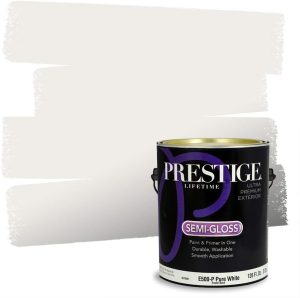
Sherwin-Williams Duration is a premium 100% acrylic latex paint renowned for its durability and UV resistance, making it ideal for sunny climates.
Key Features:
- UV Resistance: Advanced UV blockers minimize fading and chalking.
- Durability: Resists cracking, peeling, and dirt accumulation; Consumer Reports top-rated for longevity.
- Flexibility: Expands and contracts with temperature changes, preventing cracks.
- Finish Options: Available in matte, satin, and gloss; satin recommended for sun-exposed surfaces.
- Coverage: ~350-400 sq. ft. per gallon; self-priming on most surfaces.
- Price: ~$80-$90/gallon.
Pros:
- Exceptional color retention, even in intense sunlight.
- Mildew-resistant, ideal for humid, sunny regions.
- Lifetime limited warranty for peace of mind.
Cons:
- Premium price point, though justified by performance.
- Strong odor during application; use a respirator (e.g., 3M 6800).
Application Tips:
- Apply in spring or fall (50-85°F) to avoid heat-related drying issues.
- Clean surfaces with a pressure washer to remove dirt and chalking.
- Use a high-quality acrylic primer (e.g., Sherwin-Williams Multi-Surface Primer) on bare or chalky surfaces.
Best For: Homeowners in hot, sunny climates (e.g., Arizona, Florida) seeking long-lasting protection and vibrant colors.
2. Benjamin Moore Aura Exterior (Best for Color Retention)
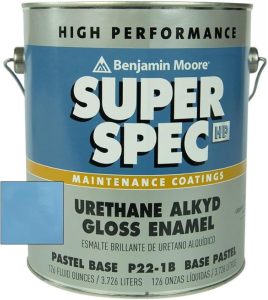
Benjamin Moore Aura Exterior is a high-end acrylic latex paint with proprietary Color Lock® technology, ensuring vibrant colors despite intense sun exposure.
Key Features:
- UV Resistance: Superior fade resistance, retaining sheen and color for years.
- Durability: Breathable, resisting blisters and peeling; scratch-resistant finish.
- Coverage: ~300-400 sq. ft. per gallon; often one-coat coverage with primer.
- Finish Options: Low lustre, satin, semi-gloss; low lustre ideal for siding.
- Price: ~$85-$95/gallon.
- Certifications: Low-VOC, eco-friendly.
Pros:
- Outstanding color retention, especially for earth tones and light colors.
- Smooth application, minimizing brush marks.
- Mildew-resistant for humid, sunny areas.
Cons:
- Expensive, but performance matches cost.
- Limited availability compared to Sherwin-Williams.
Application Tips:
- Apply on a clean, dry surface; sand glossy or peeling areas first.
- Use Benjamin Moore Fresh Start Primer for optimal adhesion on stucco or masonry.
- Avoid painting in direct sunlight to prevent lap marks.
Best For: Homeowners prioritizing vibrant, fade-resistant colors in sunny regions.
3. PPG Permanizer Exterior Acrylic (Best for Extreme Climates)
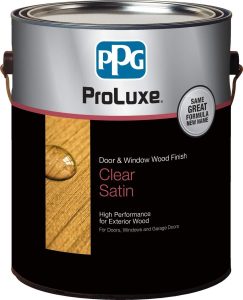
PPG Permanizer emerged as a top performer in a three-year Colorado weathering test, excelling in durability and fade resistance for harsh sun exposure.
Key Features:
- UV Resistance: High-performance UV inhibitors prevent fading and chalking.
- Durability: Resists cracking, peeling, and dirt; withstands extreme temperature swings.
- Coverage: ~350-400 sq. ft. per gallon; two coats recommended.
- Finish Options: Flat, satin, gloss; satin for best sun resistance.
- Price: ~$70-$85/gallon.
- Warranty: Lifetime transferable warranty (excludes flat surfaces).
Pros:
- Proven performance in accelerated weathering tests.
- Excellent value for premium performance.
- Enhances energy efficiency with reflective pigments.
Cons:
- Less widely available than Sherwin-Williams or Benjamin Moore.
- May require two coats for full coverage.
Application Tips:
- Apply in mild weather (50-90°F) to ensure even drying.
- Use PPG’s acrylic primer on raw wood or stucco for better adhesion.
- Consider adding PPG’s Lumen additive for enhanced UV resistance.
Best For: Homes in desert or high-altitude climates with extreme sun and temperature variations.
4. Behr Marquee Exterior (Best Value)
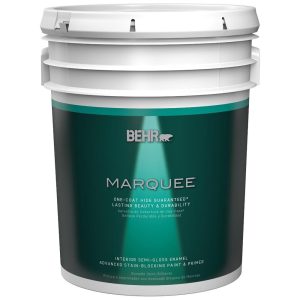
Behr Marquee is a high-quality, budget-friendly acrylic latex paint with strong UV resistance, ideal for sunny climates without breaking the bank.
Key Features:
- UV Resistance: Fade-resistant formula with titanium dioxide for lasting color.
- Durability: Resists cracking, peeling, and mildew; weatherproof for rain and sun.
- Coverage: ~300-400 sq. ft. per gallon; one-coat coverage on primed surfaces.
- Finish Options: Flat, satin, semi-gloss; satin for sun-exposed siding.
- Price: ~$50-$60/gallon.
- Availability: Widely available at Home Depot.
Pros:
- Affordable for large projects or tight budgets.
- Excellent color retention for light and neutral tones.
- Low-VOC, eco-friendly formula.
Cons:
- Slightly less durable than premium brands like Sherwin-Williams.
- Stronger odor than Benjamin Moore; ventilate well.
Application Tips:
- Clean surfaces thoroughly to remove chalking or mildew.
- Apply Behr Premium Plus Primer on bare wood or stucco.
- Use a sprayer for even coverage on textured surfaces like stucco.
Best For: DIYers or homeowners in sunny regions seeking quality on a budget.
5. NeverFade Exterior Paint (Best for Long-Term UV Resistance)
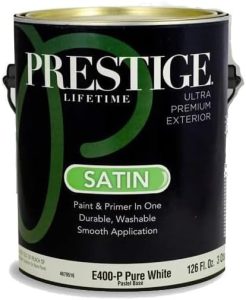
NeverFade, featuring Kynar Aquatec resin, is a specialty acrylic paint with a 15-year no-fade guarantee, perfect for intense sun exposure.
Key Features:
- UV Resistance: Kynar resin blocks UV degradation, ensuring zero fading for 15 years.
- Durability: Resists chalking, cracking, and mildew; highly weatherproof.
- Coverage: ~300-350 sq. ft. per gallon; two coats recommended.
- Finish Options: Matte, satin; satin for sun-exposed surfaces.
- Price: ~$90-$110/gallon.
- Certifications: Water-based, low-VOC.
Pros:
- Industry-leading fade resistance, ideal for vibrant or dark colors.
- Long lifespan reduces repainting frequency.
- Suitable for stucco, brick, and siding.
Cons:
- High cost, often requiring professional application.
- Limited color palette compared to major brands.
Application Tips:
- Requires professional-grade surface prep (power washing, sanding).
- Use a compatible acrylic primer for masonry or bare surfaces.
- Apply with a sprayer for best results on large areas.
Best For: Homeowners in high-UV areas (e.g., Phoenix, Miami) willing to invest in premium, no-fade performance.
Key Considerations for Choosing Exterior Paint for Sun Exposure
Paint Type
- Acrylic Latex: Best for sun exposure due to flexibility, UV resistance, and breathability. Resists cracking and fading better than oil-based paints.
- Elastomeric: Ideal for stucco or masonry; thick, flexible film prevents cracking in extreme heat.
- Oil-Based: Durable but prone to fading in intense sun; better for shaded areas or trim.
- Hybrid/Epoxy Paints: Combine acrylic and epoxy for enhanced durability; suitable for full sun but less common.
UV Resistance
- Look for paints labeled “UV-resistant” or with titanium dioxide and UV inhibitors (e.g., Sherwin-Williams Duration, NeverFade). These reflect UV rays, reducing photodegradation.
- Avoid low-quality paints with cheap pigments (talc, clay, silica), which fade quickly in direct sun.
Color Choice
- Light Colors (Whites, Beiges, Grays): Reflect sunlight, reducing heat absorption and fading. Recommended shades: Sherwin-Williams Pure White, Benjamin Moore Simply White, Behr Swiss Coffee.
- Earth Tones (Browns, Tans): Inorganic pigments resist UV breakdown better than organic reds, blues, or greens.
- Dark Colors: Absorb heat, fading faster (especially reds and dark greens); use sparingly for trim with high-quality paints like NeverFade.
- Reflective Pigments: Some paints (e.g., PPG Permanizer) include heat-reflective additives to lower surface temperatures, saving on cooling costs.
Finish Type
- Satin/Low Lustre: Balances durability, cleanability, and UV resistance; ideal for siding in sunny areas.
- Semi-Gloss/Gloss: Highly durable and reflective but highlights imperfections; best for trim or doors.
- Flat/Matte: Less durable, prone to dirt and mildew; avoid in full sun unless using a premium flat like NeverFade.
Surface Material
- Stucco: Use elastomeric or acrylic paints with breathability to prevent moisture trapping.
- Wood Siding: Acrylic latex with primer ensures adhesion and flexibility.
- Brick/Stone: Breathable acrylic or elastomeric paints allow vapor escape, preventing blisters.
- Metal/Vinyl: Use acrylic paints with specific primers (e.g., galvanized metal primer for aluminum).
Climate Factors
- High UV Areas (e.g., Arizona, Florida): Prioritize UV-resistant acrylic or elastomeric paints with light colors.
- Humidity: Choose mildew-resistant paints (e.g., Sherwin-Williams Duration) for sunny, humid regions.
- Temperature Swings: Elastomeric or acrylic paints handle expansion and contraction best.
Application Tips for Sun-Exposed Surfaces
- Surface Preparation:
- Power wash to remove dirt, mildew, and chalking; use a bleach solution (1:3 with water) for mold.
- Scrape and sand peeling or glossy areas; fill cracks with elastomeric caulk (e.g., Sherwin-Williams SherMax).
- Apply a high-quality acrylic primer (e.g., Benjamin Moore Fresh Start) on bare, chalky, or masonry surfaces.
- Timing:
- Application:
- Safety:
- Maintenance:
Why Avoid Cheap Paints in Sunny Climates?
Low-quality paints with inferior pigments (e.g., talc, silica) or low titanium dioxide content fade rapidly in direct sun, especially on southern exposures. They lack UV inhibitors, leading to chalking, cracking, and frequent repainting (every 2-3 years vs. 7-10 for premium paints). Dark colors on cheap paints, like reds or greens, can turn blotchy or yellowish, ruining curb appeal. Investing in high-quality paints like Sherwin-Williams Duration or Benjamin Moore Aura saves money long-term by reducing maintenance and repainting costs.
Bonus Tips for Sun-Exposed Painting Projects
- Test Colors: Paint a small section to see how colors look in sunlight at different times of day.
- Additives: Consider UV-enhancing additives like PPG’s Lumen for extra fade resistance.
- Awnings/Overhangs: Install awnings over doors or windows to reduce direct sun exposure.
- Hire Professionals: For large or complex projects, pros ensure proper prep and application, especially with specialty paints like NeverFade.
- Energy Savings: Light, reflective colors can lower cooling costs by reducing heat absorption.
9 Frequently Asked Questions
1. What type of paint is best for sun-exposed exteriors?
Acrylic latex paints (e.g., Sherwin-Williams Duration, Benjamin Moore Aura) are best due to their UV resistance, flexibility, and breathability. Elastomeric paints are ideal for stucco or masonry in extreme heat.
2. Do I need UV-resistant paint for sunny climates?
Yes, UV-resistant paints with titanium dioxide or Kynar resin (e.g., NeverFade) prevent fading and chalking, extending paint life by up to 50% compared to standard paints.
3. Which colors are most resistant to fading in sunlight?
Light colors (whites, beiges, grays) and earth tones (browns, tans) with inorganic pigments resist fading best. Avoid reds, blues, and dark greens, which fade faster due to organic pigments.
4. How often should I repaint in a sunny climate?
High-quality paints last 5-10 years in hot, sunny climates, depending on maintenance. Dark colors or low-quality paints may need repainting every 2-5 years.
5. Can I use oil-based paint in full sun?
Oil-based paints are durable but fade faster than acrylic latex in intense sun, making them better for shaded areas or trim.
6. Is elastomeric paint worth it for sun exposure?
Yes, elastomeric paints (e.g., Sherwin-Williams Resilience) are flexible and thick, preventing cracking on stucco or masonry in high heat, but they’re costlier and less breathable.
7. How do I prevent chalking or peeling in sunny areas?
Use UV-resistant acrylic paints, apply a quality primer, and ensure thorough surface prep (cleaning, sanding). Light colors and regular maintenance reduce chalking.
8. Are dark colors a bad choice for sunny climates?
Dark colors absorb heat, fading faster and increasing cooling costs. Use them sparingly (e.g., trim) with premium paints like NeverFade for better retention.
9. Should I hire a professional for painting in sunny climates?
For best results, especially with stucco or specialty paints, professionals ensure proper prep and application, maximizing durability in harsh sunlight.
Conclusion
Choosing the right exterior paint for sun exposure is crucial to protect your home from UV rays, heat, and fading while maintaining curb appeal. Sherwin-Williams Duration Exterior is the best overall, offering unmatched durability and UV resistance for hot climates. Benjamin Moore Aura Exterior excels for vibrant color retention, while PPG Permanizer is a top pick for extreme conditions. For budget-conscious homeowners, Behr Marquee delivers strong performance at a lower cost, and NeverFade guarantees no fading for 15 years.
Opt for light or earth-toned acrylic latex or elastomeric paints, apply in mild weather, and prep surfaces thoroughly for a finish that lasts 7-10 years. With the right paint, your home can stand up to the sun and look stunning for years to come. Grab your brush or call a pro, and let your home shine!
Happy painting!


Leave a Reply